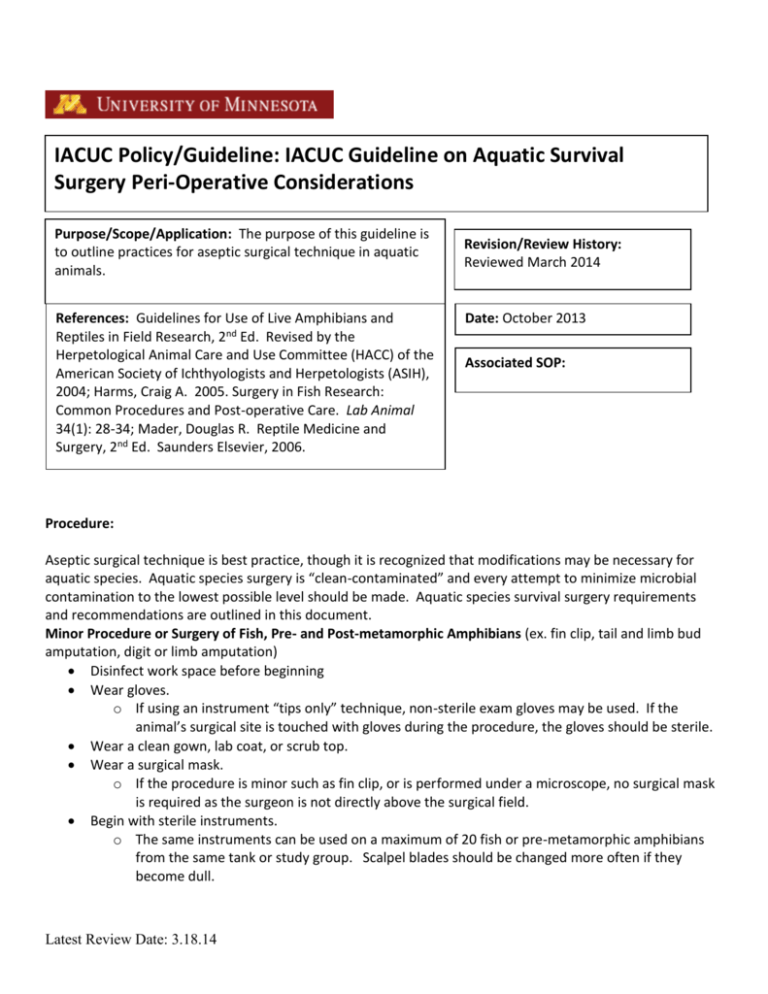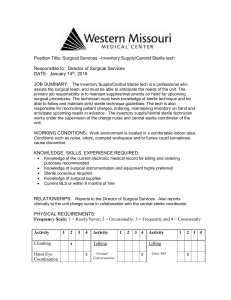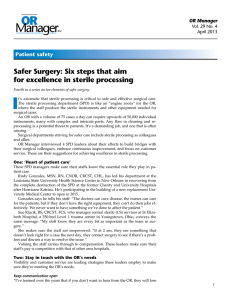Aquatic Survival Surgery Peri
advertisement

IACUC Policy/Guideline: IACUC Guideline on Aquatic Survival Surgery Peri-Operative Considerations Purpose/Scope/Application: The purpose of this guideline is to outline practices for aseptic surgical technique in aquatic animals. References: Guidelines for Use of Live Amphibians and Reptiles in Field Research, 2nd Ed. Revised by the Herpetological Animal Care and Use Committee (HACC) of the American Society of Ichthyologists and Herpetologists (ASIH), 2004; Harms, Craig A. 2005. Surgery in Fish Research: Common Procedures and Post-operative Care. Lab Animal 34(1): 28-34; Mader, Douglas R. Reptile Medicine and Surgery, 2nd Ed. Saunders Elsevier, 2006. Revision/Review History: Reviewed March 2014 Date: October 2013 Associated SOP: Procedure: Aseptic surgical technique is best practice, though it is recognized that modifications may be necessary for aquatic species. Aquatic species surgery is “clean-contaminated” and every attempt to minimize microbial contamination to the lowest possible level should be made. Aquatic species survival surgery requirements and recommendations are outlined in this document. Minor Procedure or Surgery of Fish, Pre- and Post-metamorphic Amphibians (ex. fin clip, tail and limb bud amputation, digit or limb amputation) Disinfect work space before beginning Wear gloves. o If using an instrument “tips only” technique, non-sterile exam gloves may be used. If the animal’s surgical site is touched with gloves during the procedure, the gloves should be sterile. Wear a clean gown, lab coat, or scrub top. Wear a surgical mask. o If the procedure is minor such as fin clip, or is performed under a microscope, no surgical mask is required as the surgeon is not directly above the surgical field. Begin with sterile instruments. o The same instruments can be used on a maximum of 20 fish or pre-metamorphic amphibians from the same tank or study group. Scalpel blades should be changed more often if they become dull. Latest Review Date: 3.18.14 o The same instruments can be used on a maximum of 6 post-metamorphic amphibians providing they are cleaned of gross debris and disinfected between animals. Options include placing instrument tips in a glass bead sterilizer or using chemical disinfection (ethanol or chlorhexidine) between animals, or using a new scalpel blade for each animal. Chemical disinfectants should be thoroughly rinsed away before using the instrument on the amphibian to prevent them from absorbing the chemical. Remove any gross debris from the amputation site with a rinse. o Rinse solution options include sterile saline, sterile water, anesthetic-impregnated water, or amphibian ringer’s solution. Major Survival Surgery of Fish and Amphibians (ex. surgical harvest of oocytes or testicles, other entry into the body cavity) Disinfect surgery work area before beginning. Wear a new pair of sterile gloves for each animal. o Alternately, if an instrument “tips only” method is used, exam gloves are acceptable. Wear a clean gown, lab coat, or scrub top. Wear a surgical mask. Maintain a sterile field for instruments and sterile materials. Use sterile instruments. Sterilization can be achieved by autoclaving or gas sterilization. o The same instrument pack can be used for multiple animals (maximum of 6 individuals) if glass bead sterilization or chemical disinfection is used on the instruments between them. o Chemical disinfectants should be thoroughly rinsed away before using the instrument on the amphibian to prevent them from absorbing the chemical. Thoroughly rinse skin over surgical site to remove gross debris. o Rinse solution options include sterile saline, sterile water, or amphibian ringer’s solution. Alternatively, a 0.75% chlorhexidine solution can be gently applied with a cotton applicator to the incision site for a contact time of 10 minutes. Exceptions If you need an exception to these requirements, in your protocol please detail the desired change and provide justification. Studies involving wildlife in field conditions may require modification of these requirements. Efforts should be made to minimize microbial contamination to the lowest possible level. When writing your protocol, fully describe the field techniques to be utilized. Recommended for major surgery, but not required: -Cap or bonnet. -Non-adhesive drape. The value of drapes in aquatics surgery remains controversial. -Fast animals for 12 hours (ranges reported were 4-48 depending on species) to prevent regurgitation of stomach contents with handling and/or anesthesia. -Record a pre-operative weight (in adult amphibians). Latest Review Date: 3.18.14 Current standard of care guidelines from more than twenty similar animal care and use programs at colleges and universities across the United States were reviewed. Latest Review Date: 3.18.14






